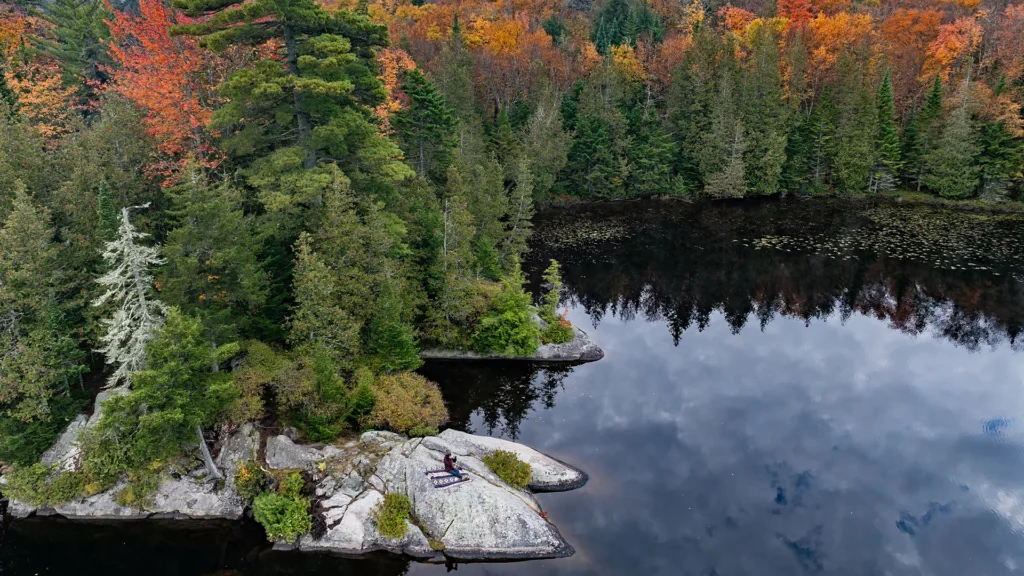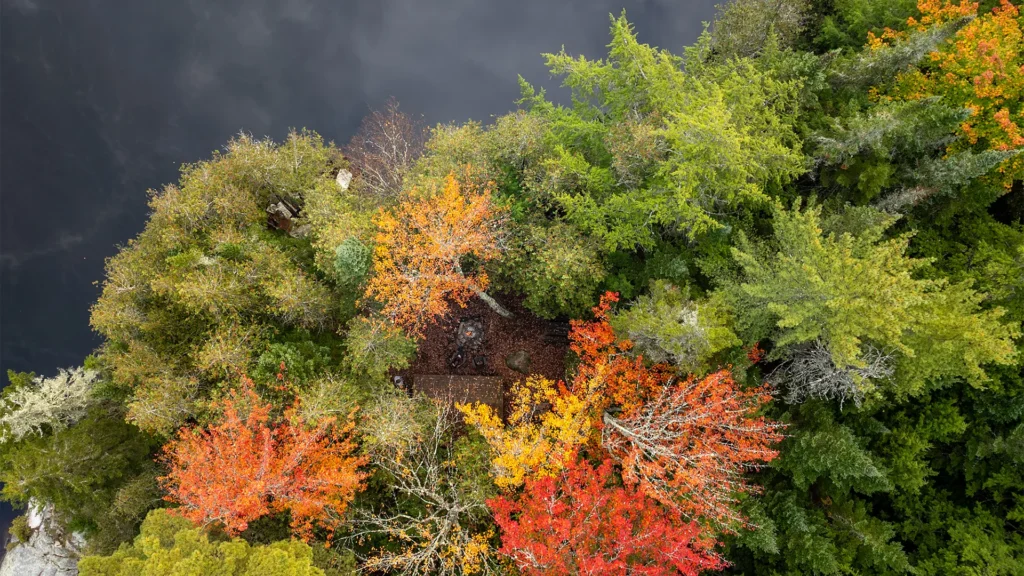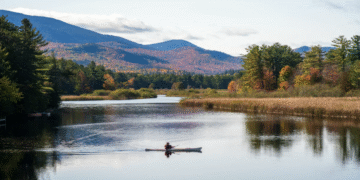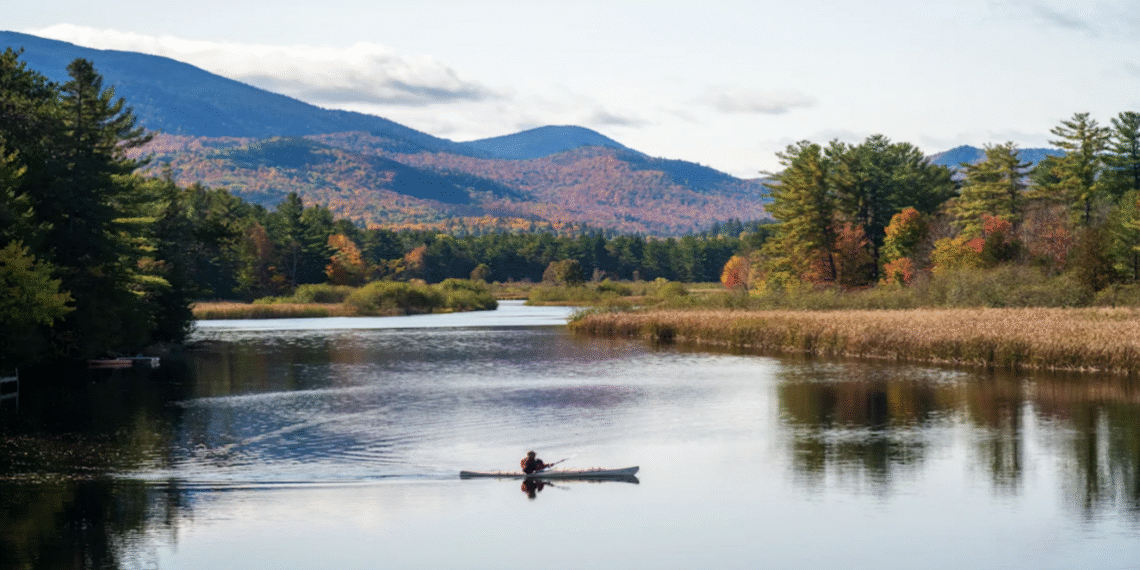In the heart of New York State lies the Adirondack Park, a staggering expanse of wilderness more than six million acres in size, where dense woods, looming mountain peaks, and glacial lakes converge in an autumn spectacle unlike any other. As summer’s vibrant greens give way to russet reds, golden yellows, and burnt oranges, leaf-peeping becomes more than a pastime—it becomes a journey into antiquity, a way to view nature as those before us did, through quiet waters and unspoiled shores. In September 2025, the Adirondacks offer that opportunity in full, inviting those who seek to witness the changing season in its purest form, by canoe across hidden lakes and through silent rivers, beneath a canopy that blazes across the skyline.
Ancient paddles slice across glasslike water as dawn rises over remote lakes deep in the Adirondacks, where light first kisses the trembling leaves and glassy reflections become mirrors of fire. Canoeing is more than an adventure here; it is a tradition, echoing back to native peoples, early explorers, and the guides who first understood that the true heart of this landscape lies not on paved roads or at roadside lookouts, but in the waterways. Branches hang low with color, and every ripple in the water refracts a thousand hues of autumn. Paddles dip in rhythm, carrying visitors through corridors of trees, their trunks mottled and bold, leaf litter drifting softly in their wake.
Late September is when the woods begin to shift most dramatically: sugar maples flame in scarlets, birches flare in gold, oaks deepen to shade of russet and chocolate, aspens flicker in pale chartreuse. The cooler nights accentuate the transformation, drawing out pigments hidden through summer. Each bend of river, each glacial pond becomes a canvas. Canoe camping amplifies the experience, offering nights beneath stars, mornings in mist, and hours in which time itself seems to pause. Camping lean-tos, tent platforms near water’s edge, primitive sites with only the essentials—fire ring, modest shelter—echo the simplicity of earlier eras, when people traveled by foot and craft rather than vehicle or highway. There is a rhythm to this kind of travel: load the canoe, portage when necessary, set camp before dusk, sleep to the whisper of wind in branches.
A route through Newcomb Lake captures the spirit of ancient leaf-peeping. Accessible only by foot, bike, or horse-drawn wagon to the lake launch, the journey itself becomes a transformation. The farm roads give way to forest trails, and moss-carpeted paths lead to shores fringed with balsam and pine. Canoe outfitters drop off canoes at remote launch points, guiding paddlers to hidden waters. On the lake, one glides past shorelines dotted with scarlet sumac and golden beech, each tree distinct, each cove offering a unique angle on color. The mirror-still surface of water reflects sky and foliage alike; a single stone on the shore, a fallen log half submerged, becomes foreground in a living painting.
Mornings begin in mist as loons call across glassy bays. Dawn breaks slowly over ridgelines, soft light filtering through thinning fog, turning each branch into a silhouette edged in gold. The air smells of wet leaves and pine duff, of cold water and earth. Sounds are minimal: the dipping of paddle, the rustling of leaves overhead, and the distant echo of a loon’s cry. In these hours, the world seems suspended, as if autumn has paused to behold itself. Midday brings more clarity; warm sunlight penetrates the canopy, brightening leaves from deep burgundy at far height to copper tones low down. Shadows stretch and shift, dancing across waves as light plays upon the water.
Evenings settle early. Campsites choose themselves by comfort of shore, access to clean water, views of dusk. Fires crackle, stars swing into view above the barest of ceilings, unpolluted by city glow. The moon reflects on water, and the milky way threads across sky. Leaves, damp from dew, rustle in breeze. Camp rituals are simple: silence, reflection, warmth. Lanterns dim, night deepens, and the forest exhales into darkness.
Paddling after sunset reveals a different canvas. The air cools rapidly; red and orange tones deepen to sanguine, golds to amber. Twilight lingers on the horizon, and silhouettes of pines frame the dying light. Water becomes a silky black ribbon, reflecting torchlight or moon. The forest seems to close in just enough, enclosing the experience in something sacred. Stars emerge, faint at first, then bold—Orion, Cassiopeia, the band of the Milky Way—overhead. Dawn again follows darkness, cold and expectant.
In remote backcountry wilderness there are no crowds. No traffic, no paved lookouts with parking lots. Only canoeists, early birds rising with the first glow, and the ever-present forest. Leaf-peeping by automobile along scenic roads will show seasonal colors, but from a canoe the view is immersive. The reflection of trees on water doubles the spectacle; the hush of ripples and the slight dip of paddle feel ancient. To drift across silent lakes, to portage between connected ponds, to camp in lean-tos built decades past, is to travel not just through space but through time.
The Adirondacks in autumn, as September gives way to October, become a classroom of color, a place where one can witness decay and rebirth in every falling leaf. Greens fade, reds deepen, yellows radiate. Beneath the surface, roots store food, sap ceases its upward march. Above, branches peel away, petals and leaves descend in soft showers. Fallen leaves create a mosaic along forest floor and shorelines. Mosses glow, fungi erupt in hidden clearings, and wildlife stirs in preparation for winter. Loons patrol their stretches of water, ducks assemble in sheltered bays, squirrels gather nuts, and deer drift into edge zones. The forest is alive with motion even as color dominates.

Canoes give access to hidden corners. Some lakes and ponds are bordered by wetlands, uncertainly firm at the edges, where ankle-deep water and fallen trees mingle before yielding to deep water. Herons stand on crooked roots, geese fly low across mirrored surfaces, kingfishers flash iridescent blue. At sunset, osprey silhouette against crimson sky. Reflections create illusions: trees inverted on water, clouds mirrored to two skies. One paddle stroke can carry a wardrobe of color; one portage can shift from dense conifers to birches ablaze.
Clouds matter in this tableau. Clear skies bring brilliance; overcast light diffuses color, shadows soften, contrasts mellow. Rain before frost can intensify color; frost itself seals in pigment. Nights dropping below freezing at high elevation turn edges brown first, sealing some reds into russet. Leaf ecologists monitor heat, humidity, daylight; local guides note weather shifts that deepen tones. Visitors by canoe drift into this realm, living in weather’s interplays.
The landscape is layered with history. Ancient stones—glacial erratics—rest along lake edges. Campsites built long ago sit beneath towering pines. Trails once trod by Indigenous peoples, early trappers, artisans of forest, still connect water routes. Canoe routes echo trade paths and stories. Each lake has its lineage: families, explorers, writers who visited in earlier centuries, sharing images of color and water in letters and paintings. To paddle here is to enact a ritual of remembrance, to place oneself in a continuum of those who have loved these woods before, and those who will follow.

The human presence is minimal: lean-tos weathered by seasons, fire pits blackened with age, picnic tables mossing over. Simple journal entries record nights pressed against thin canvas tents. Boots wet in the morning light. Campfires scent the air. Sit quietly, listen to the loons, watch the leaves drift. Silence feels earned.
Return journeys unfold slowly. Docks grow near, horses clip-clop away on forest roads, trails bring hikers and paddleists toward parking areas. But the transition is gradual: from remote water to trail to road, from wind and wilderness to engine hum. Colors linger in memory: golds behind eyelids, reds at fingertips, the cool taste of lake water, the rush of wind through trees. Photographs capture shape but not sound; journals mark light but not warmth. The ancient pathway by canoe remains with those who travel it.
This autumn in the Adirondacks, the ancient way of leaf-peeping by canoe invites those who wish to see beyond the ordinary: to drift beneath a roof of flame-lit leaves; to wake beneath mist and paddle at sunrise; to touch the edge of wilderness. The forest ages, the leaves turn, water reflects, and in that movement there is magic. For those who witness, canoe becomes a vessel through time, carrying one through the seasons, through history, through silence.
















